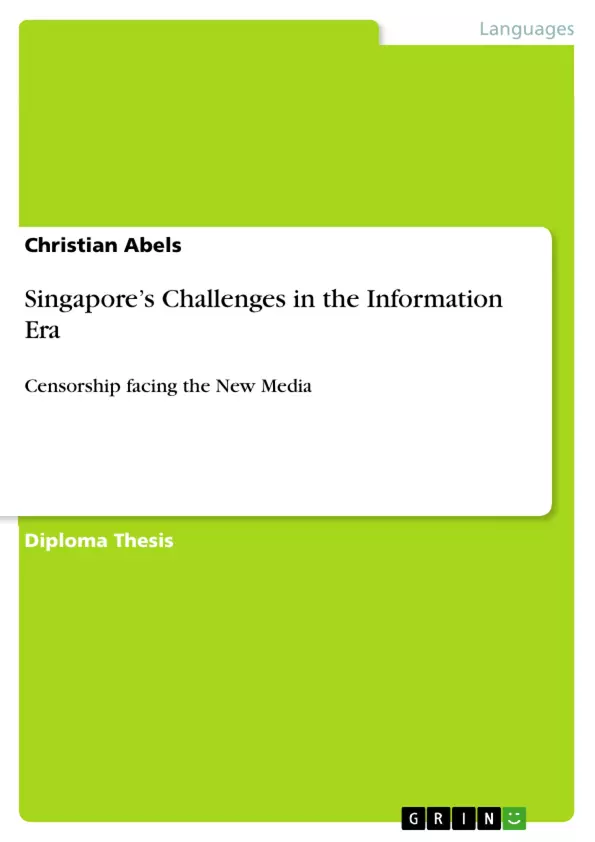Singapore’s media system has been stable through a period of revolutionary change and impressive reform elsewhere. While new players and technologies have found its way into the media scene, the ruling People’s Action Party’s (PAP) upholds the media’s fundamental structure. Historical racial rioting has been linked to justify the subordinate role of the press. In contrast to the Western Press which is often denominated as the ‘fourth estate’ of the state, the Singaporean press is rather to support the PAP’s politics.
Due to different political, historical, cultural and economic environment, authoritarian politicians in Southeast Asia argue that freedom of the press, as a Western concept, has a different meaning and weight unlike in the Western industrial nations because of its different value system. The Asian values require the harmony between the press and the state as in the ‘partners in nationbuilding’ to maintain its authoritarian governance and at the same time sharing a common interest in economic growth.
Singapore’s government has promoted and established sophisticated information and communication technologies amongst the first. Nowadays, Singapore can consider itself as one of the most developed and best networked states in the world.
Feared by the challenges of the New Media and the free and open exchange which might lead to confusion and opposition to the PAP’s activities, the government enacted laws and encouraged a system of censorship to tame the press. The well-functioning system consists of legal restrictions, technical filters and informal censorship, such as self-censorship.
A closer look at this pragmatic and sensitive approach of censorship, Singapore’s government seems prepared to deal with the New Media and further challenges.
Inhaltsverzeichnis (Table of Contents)
- Abstract
- List of Contents
- Preface
- The Press Scene in Singapore
- Towards Independence (1959-1965)
- Independence (1965)
- Singapore's Media Scene Today
- Summary
- Journalism in Asia
- Freedom of the Press in Asia
- Freedom of the Press
- Asian Values
- Asian Journalism
- Freedom of the Press in Singapore
- Freedom from the Press
- Economic Freedom
- Summary
- The Internet in Singapore
- The Internet as Information Medium
- The Internet in Singapore
- Summary
- Censorship and the Internet
- Legal Regulations
- Filtering
- Informal Restrictions for Censorship
- Self-Censorship in Singapore
- OB Markers
- Summary
- Conclusion
- List of References
- The historically rooted subordinate role of Singapore's press
- The impact of Asian values on freedom of the press and media control
- The government's strategies for managing the internet, including legal regulations and informal censorship
- The effectiveness of Singapore's censorship system in the face of the New Media and its challenges
- The balance between economic development and political control in Singapore's information policies
- The Press Scene in Singapore: This chapter provides a historical overview of Singapore's press, highlighting its subordinate role to the government since the People's Action Party's rise to power in 1959. It explores the evolution of the press scene, from the period leading up to independence to the present day.
- Journalism in Asia: This chapter examines the broader context of freedom of the press in Asia, contrasting the Western ideal of a free press with the prevailing views in Southeast Asia. It explores the concept of Asian values and their implications for media control, as well as the unique characteristics of Asian journalism.
- The Internet in Singapore: This chapter analyzes the rapid development of the internet in Singapore and its potential impact on information flow and political control. It discusses the government's efforts to promote the internet as a tool for economic development while simultaneously managing its potential for political dissent.
- Censorship and the Internet: This chapter focuses on the specific methods employed by the Singaporean government to control online content. It explores legal regulations, technical filtering mechanisms, and informal forms of censorship such as self-censorship and the use of OB markers.
Zielsetzung und Themenschwerpunkte (Objectives and Key Themes)
This thesis aims to analyze the censorship system in Singapore and the challenges it faces in the Information Era. The author explores how the government manages the increasing flow of information, particularly through the internet, while maintaining its political hegemony.
Zusammenfassung der Kapitel (Chapter Summaries)
Schlüsselwörter (Keywords)
This thesis explores the core concepts of censorship, media control, and freedom of the press within the context of Singapore's information policies. Key themes include the role of Asian values, the impact of the internet, legal regulations, informal censorship, and the balance between economic development and political control.
- Arbeit zitieren
- Christian Abels (Autor:in), 2009, Singapore’s Challenges in the Information Era, München, GRIN Verlag, https://www.grin.com/document/187527



